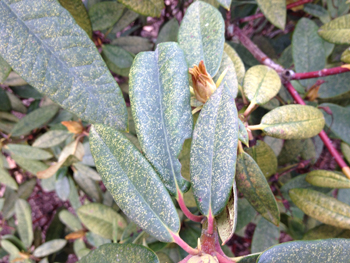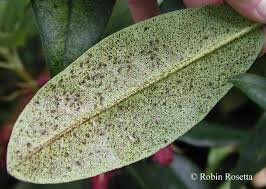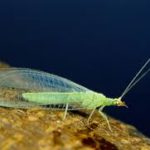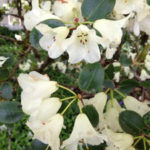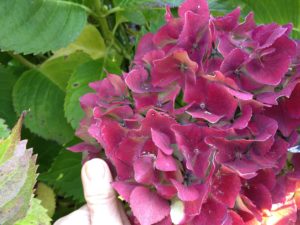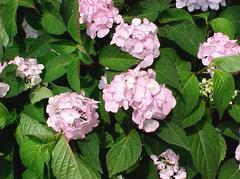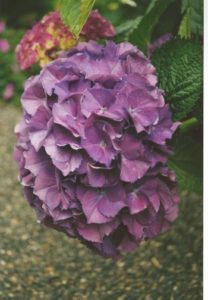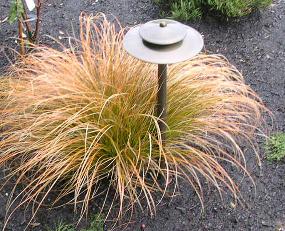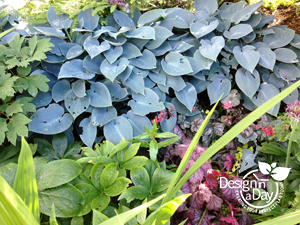
Root weevil damage distracts from an otherwise beautiful collection of shade loving plants.
Designers List of Shade Plants for Root Weevil Resistance
Root weevil disfigure so many shade garden plants and can make a garden look ravaged. It’s disappointing to see hosta and other plant leaves looking all chewed up. Can we design a shade garden with beauty and style without using root weevil favorite snack plants?
“Well HELL that’s not much of a shade garden” is what I said after eliminating plants root weevil like to eat. I was disappointed in the tiny number of plants that would work and wandered off to write about something different, something a bit cheerier!!!! However, I’ve been thinking about it and yes, we have some great plants we can use.
Evergreen Shrubs
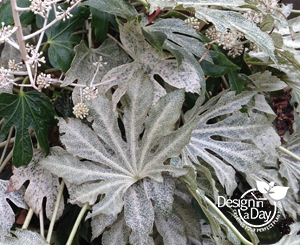
Sometimes choosing an interesting variegated leaf, such as this Fatsia japonica ‘Spider’s Web’ can hide the notching caused by Root Weevil (look close!)
Aucuba, Daphne and Fatsia are not root weevil favorites and if you select the variegated forms the notching doesn’t show as much. To be specific, Daphne odora ‘Marginata’, Fatsia japonica ‘Spider’s Web’, and Aucuba japonica ‘ Gold Dust’ are varieties that I recommend.
I have never seen much leaf damage on our Native Huckleberry (Vaccinium ovatum) probably because the leaves are so tiny. It doesn’t show which is what we are after.
Three Root Weevil Resistant Rhododendron for Part Shade
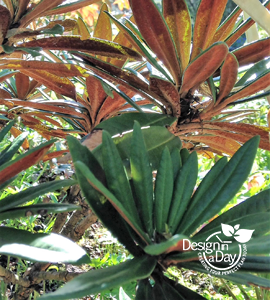
The fuzziness on the bottom of the leaves on some Rhododendrons reduce Root Weevil damage.
I’ve found lists of root weevil resistant rhododendron less than helpful since most Rhododendron listed are sun lovers. Root weevil prefer part shade to shade loving plants.
Rhododendron ‘Clipiense’ is my best weevil resistant compact rhododendron for shadier situations. This rhody has fine hairs on the leaves so root weevil rarely bother it. It’s a slower growing variety and can take more shade than the other two I have listed but not deep shade. Any rhododendron with a hairy or fuzzy leaf will be root weevil resistant. Many of the hairier leafed plants are sun lovers but not all.
Rhododendron ‘Sappho’ is a tall white flowered w burgandy splotched flower. Sappho does well in morning sun, dapples and afternoon shade.
Rhododendron ‘Blue Diamond’ can take full sun but does well in full am sun and afternoon shade. It can get taller than wide.
Perennials
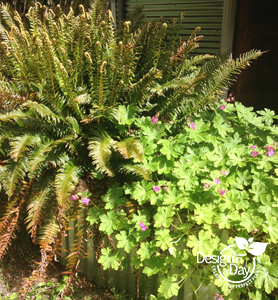
Sword fern (Polystichum munitum) and Hardy Geranium (Geranium macrorrhizum) do not show Root Weevil damage.
Sword fern (Polystichum munitum) has a fuzzy frond (leaf) and root weevil don’t eat fuzzy leaves typically. Most fuzzy fronded ferns will be root weevil resistant and are an important player in a root weevil free planting.
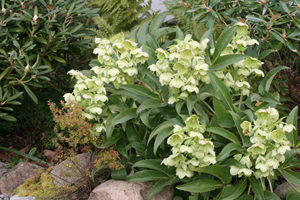
Helleborus argutifolius photo credit: Great Plant Picks
Hellebores are typically safe from weevil once they are mature plants. When the soft and munchable new leaves unfurl in February the root weevil have not hatched yet (here in Portland) so are not present until late April or May. The harder leafed hellebores like Helleborus argutifolius seem particularly impervious.
Groundcover Plants
Oregon Oxalis (Oxalis oregana) doesn’t seem to get a lot of weevil attention in my gardens and it is fun to add to salads. Same with our native piggy back plant Tolmiea menziesii. It has hairy leaves and is great for shade. For Saxifraga varieties, use the hairy leaved varieties for weevil resistance, the smoother ones are on the weevil munch list. Hardy geranium varieties that smell like cedar and have a fuzzy leaf are 100% weevil resistant – Geranium macrorrhizum for deep to moderate shade and Geranium x cantabrigiense for part sun areas. Another good bet is Sweet woodruff (Galium odoratum)
Last but not least, Euphorbia Rob’s spurge (Euphorbia amygdaloides var. robbiae) is a tough evergreen ground covering shade plant. I consider it a thug but it’s great to use in gardens where I have a path that doubles as barrier to their creeping roots. This plants roots must be contained or it will march right over your hostas. I’ve never seen any root weevil damage on this plant.
Know Thy Enemy?
Root Weevil have no natural predator here in the Pacific Northwest so it’s rare to find a shade garden without them. We can cut the population of root weevil down to tolerable numbers and thus get our beautiful shade garden back. Read my blog “Attack of the Root Weevils” to learn what can be done to reduce their population in your garden.

